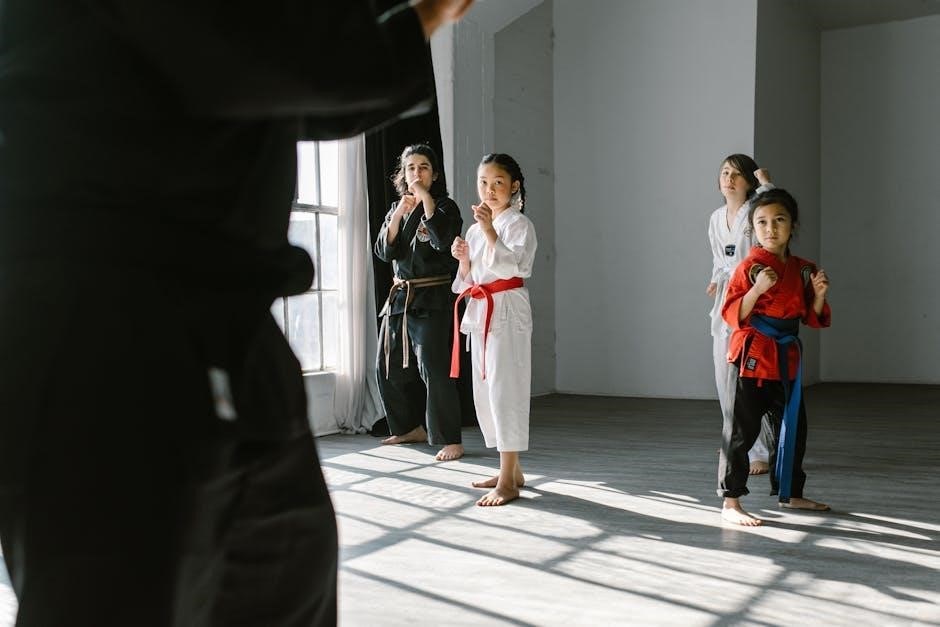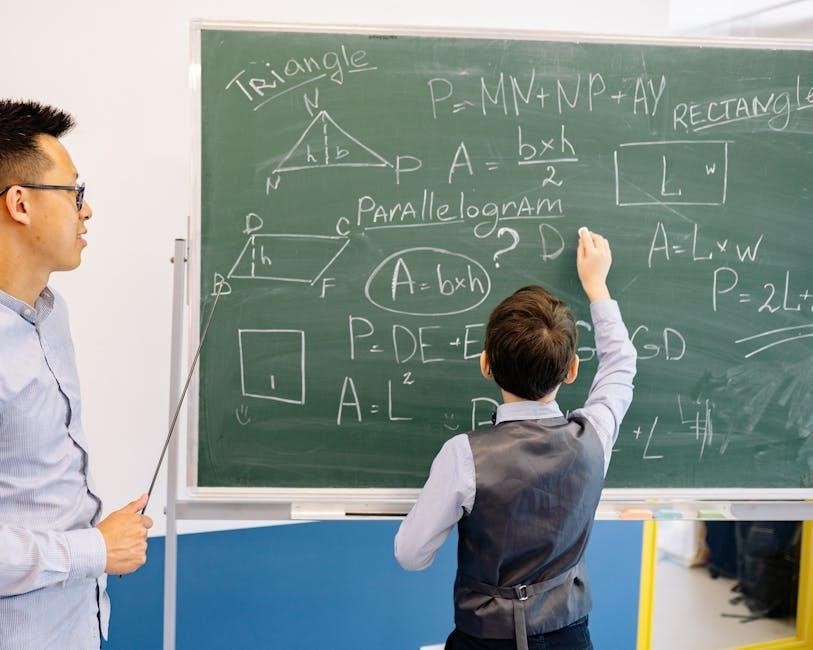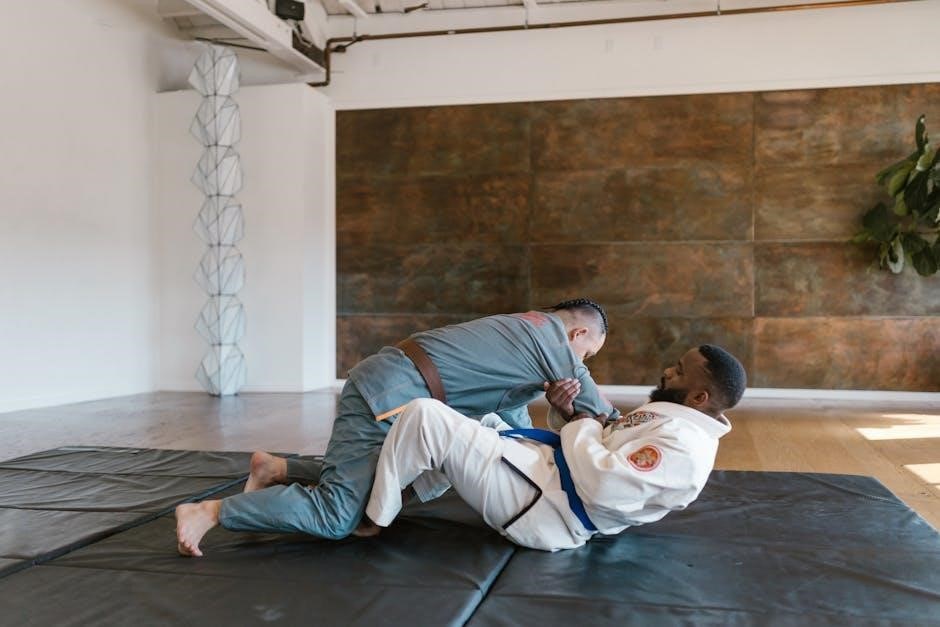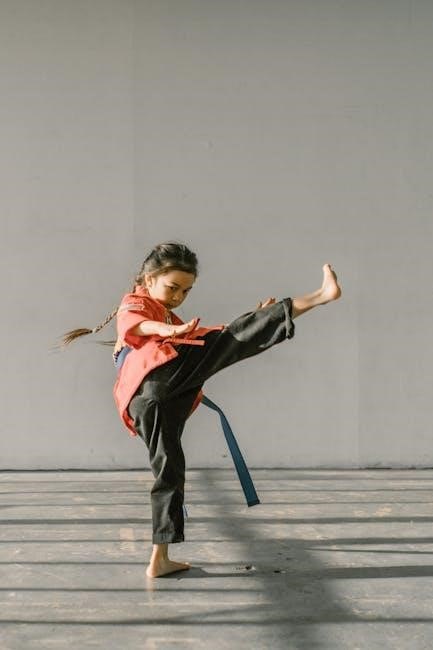Jiu Jitsu instructionals are comprehensive guides offering detailed techniques, strategies, and principles. They cover essential moves like escapes, guard positions, and submissions, helping practitioners improve skills and confidence systematically.
What are Jiu Jitsu Instructionals?
Jiu Jitsu instructionals are detailed guides that teach various techniques, strategies, and principles of Brazilian Jiu Jitsu. They are designed to help practitioners of all levels improve their skills, from fundamental movements to advanced systems. These resources often include step-by-step demonstrations, explanations of key concepts, and practical applications of techniques. Instructionals can be found in formats such as DVDs, online courses, and instructional videos, making them accessible to learners worldwide. They typically cover essential areas like escapes, guard positions, submissions, and transitions, providing a structured approach to mastering the art. Many instructionals are created by experienced instructors and world-class competitors, ensuring high-quality content. Whether for self-defense, competition, or personal growth, Jiu Jitsu instructionals serve as invaluable tools for anyone looking to deepen their understanding and proficiency in BJJ.
- Cover fundamental and advanced techniques.
- Include step-by-step demonstrations and explanations.
- Available in various formats like DVDs and online courses.
- Created by experienced instructors and champions.
Evolution of Instructional Content
Over the years, Jiu Jitsu instructional content has evolved significantly, adapting to advancements in technology and changes in training methodologies. Traditionally, instructionals were shared through in-person classes or DVDs, but the rise of digital platforms has made high-quality content more accessible. Today, online courses, video tutorials, and instructional DVDs provide detailed breakdowns of techniques, strategies, and principles. Modern instructionals often focus on systematic approaches, emphasizing the importance of understanding concepts over memorizing individual moves. Additionally, the inclusion of drills, sparring footage, and real-life applications has enhanced the learning experience. Many top instructors now offer structured programs tailored to different skill levels, from beginners to advanced practitioners. This evolution ensures that learners can progress effectively, whether training for self-defense, competition, or personal development.
- Shift from DVDs to online platforms.
- Increased focus on systematic learning.
- Inclusion of drills and real-life applications.
- Structured programs for all skill levels.
Benefits for Learners
Jiu Jitsu instructionals offer numerous benefits for learners, providing a structured and accessible way to master techniques. They enable practitioners to learn at their own pace, reinforcing fundamental concepts like escapes, guard positions, and submissions. Instructionals also enhance safety by teaching proper execution and control, reducing the risk of injury. For beginners, they build confidence and a strong foundation, while advanced learners can refine strategies and explore complex systems; Additionally, instructionals foster mental discipline, improving focus and problem-solving skills. They are ideal for those training for self-defense, fitness, or competition, offering insights from expert instructors. By breaking down techniques into clear, step-by-step guidance, instructionals make Jiu Jitsu accessible to everyone, regardless of skill level or training environment.
- Structured learning at your own pace.
- Reinforcement of fundamental techniques.
- Improved safety through proper execution.
- Enhanced mental discipline and focus.
- Expert guidance for all skill levels.

Fundamental Principles of Jiu Jitsu
Jiu Jitsu revolves around core principles like leverage, timing, and balance to overcome larger opponents. Proper breathing and body positioning are essential for effective technique execution and energy conservation.
- Leverage maximizes power efficiency.
- Timing ensures precise movement.
- Balance maintains control and stability.
- Proper breathing enhances endurance.
Essential Concepts
Mastering essential concepts is crucial for progress in Jiu Jitsu. These include understanding leverage, timing, and body positioning to maximize efficiency. Key principles like base, balance, and weight distribution ensure stability and control. Students learn to prioritize escapes and guard positions to maintain safety and create opportunities for counterattacks. Submissions and transitions are introduced to develop offensive skills, while defense against common attacks builds resilience. Drills and sparring reinforce these concepts, helping practitioners apply techniques in real-time situations. Consistent training and feedback from instructors refine execution, ensuring a strong foundation for advanced learning. These fundamental ideas form the backbone of Jiu Jitsu, enabling practitioners to adapt and evolve their skills effectively.
Importance of Drills

Drills are a cornerstone of Jiu Jitsu instructionals, serving as a bridge between theory and practical application. They help practitioners develop muscle memory and reflexes, allowing techniques to become second nature. By repeating specific movements, such as shrimping, bridging, or guard passes, students improve coordination and timing. Drills also enhance conditioning and mental focus, preparing athletes for the physical and mental demands of live sparring. Instructional drills often focus on high-percentage techniques, ensuring learners master the fundamentals before advancing. They provide a structured way to practice transitions, submissions, and escapes, making complex movements more accessible. Regular drilling accelerates progress, builds confidence, and strengthens the foundation necessary for advanced techniques. Through consistent practice, drills transform raw skills into polished, effective Jiu Jitsu.
Role of Sparring
Sparring, or “rolling,” is a vital component of Jiu Jitsu instructionals, allowing practitioners to apply techniques in real-time situations. It provides a dynamic environment to test skills, adapt to different styles, and refine strategies under pressure. Through sparring, learners develop timing, balance, and the ability to react instinctively. It also builds physical endurance and mental resilience, essential for competitive scenarios. Instructional content often emphasizes the importance of controlled sparring to ensure safety and maximize learning. By simulating real matches, sparring helps bridge the gap between drills and live action, enabling students to identify strengths and areas for improvement. Regular sparring fosters adaptability and creativity on the mat, while reinforcing the principles taught in instructionals. It is through sparring that techniques truly come to life, transforming theory into practical, effective application.

Basic Techniques for Beginners
Mastering essential techniques like escapes, guard positions, and submissions is crucial for beginners. These foundational moves build a strong base, enhancing safety, control, and confidence on the mat.
Escapes
Escapes are fundamental techniques in Jiu Jitsu, allowing practitioners to safely exit unfavorable positions. For beginners, mastering escapes is crucial for building confidence and control. One popular escape is the Kipping Escape, demonstrated by Brian Glick, which involves creating space by bridging and shifting weight. This technique is especially effective from the mount position, a common scenario in both gi and no-gi training. Proper timing and body positioning are key to executing escapes effectively. Beginners should focus on drills that simulate real-world situations, helping them develop muscle memory and reaction speed. Escapes not only prevent submissions but also transition into more advantageous positions, emphasizing the importance of defense in Jiu Jitsu. By practicing these techniques consistently, learners can improve their overall game and reduce the risk of injury during training.
Guard Positions
Guard positions are essential in Jiu Jitsu, allowing practitioners to control and defend against opponents from their backs. The closed guard, where the legs are wrapped around the opponent, is a fundamental position for beginners, offering stability and protection. The open guard enables offensive maneuvers like sweeps and submissions by using the legs to disrupt the opponent’s balance. Variations such as the half guard and spider guard provide additional options for advancing and controlling positions. Mastering guard positions is vital for building a strong foundation, as they allow learners to transition smoothly between defensive and offensive strategies. Instructionals often emphasize proper body alignment, grip control, and timing to maximize the effectiveness of these techniques. By practicing guard positions regularly, students can improve their ability to neutralize threats and create opportunities for counterattacks, making them a cornerstone of Jiu Jitsu training.
Submissions
Submissions are techniques designed to force an opponent to surrender, typically by applying pressure to joints or restricting airflow. Common submissions include armbars, chokes, and joint locks. These techniques are fundamental in Jiu Jitsu, as they allow practitioners to end matches decisively. Instructionals often detail proper execution, emphasizing timing, leverage, and control. For example, the rear-naked choke is a highly effective submission that targets the neck, while the triangle choke uses the legs to apply pressure. Mastering submissions requires precision and practice, as improper technique can lead to injury. Beginners are encouraged to focus on high-percentage submissions like the guillotine choke and Americana shoulder lock, which are versatile and effective in various situations; Submissions showcase Jiu Jitsu’s emphasis on technique over strength, making them accessible to all practitioners regardless of size or power.
Transitions
Transitions in Jiu Jitsu refer to the movements that allow practitioners to shift seamlessly between positions, maintaining control and creating opportunities for attacks. These movements are crucial for both offense and defense, enabling smooth progression from one technique to another. Instructionals often highlight the importance of mastering transitions, such as moving from guard to mount or transitioning into side control. Techniques like shrimping and bridging are essential for creating space and improving position. Proper timing and body awareness are key to executing transitions effectively. For example, transitioning from a closed guard to an open guard can set up sweeps or submissions. Instructionals emphasize drills to practice these movements, ensuring they become second nature. Mastering transitions enhances fluidity in training and competition, allowing practitioners to outmaneuver opponents and maintain a dominant position. They are a cornerstone of Jiu Jitsu, bridging the gap between defensive and offensive strategies seamlessly.

Advanced Techniques and Strategies
Advanced Jiu Jitsu techniques involve sophisticated strategies like guard passing, sweeps, and submission chains. These methods require precision, timing, and fluidity, allowing practitioners to dominate in higher-level training and competition scenarios effectively.
Guard Passing
Guard passing is a critical advanced technique in Jiu Jitsu, focusing on navigating and controlling an opponent’s guard to achieve a dominant position. It involves precise movements, balance, and pressure application to break down defenses. Techniques like the knee slide and double under passes are commonly taught in instructionals, emphasizing the importance of timing and body positioning. Proper guard passing requires a deep understanding of leverage and weight distribution to maintain control while minimizing energy expenditure. Instructionals often highlight the importance of transitioning smoothly from one position to another, ensuring fluidity in execution. Advanced guard passing strategies also incorporate submissions and transitions to capitalize on openings created during the pass. Practicing these techniques regularly helps refine timing and precision, making guard passing a cornerstone of any advanced Jiu Jitsu game. Mastering these strategies enhances overall performance in both training and competition settings.

Sweeps

Sweeps are fundamental techniques in Jiu Jitsu that allow practitioners to reverse positions, transitioning from the bottom to the top. They are essential for maintaining control and dictating the pace of a match. Instructionals often emphasize the importance of timing, balance, and body positioning when executing sweeps. Techniques like the scissor sweep and flower sweep are commonly taught, focusing on using the legs and hips to off-balance opponents. Advanced sweeps, such as the de la riva sweep, incorporate dynamic movements and leverage to achieve a reversal. Proper execution requires a deep understanding of weight distribution and pressure points. Instructionals also highlight the importance of chaining sweeps with other techniques, creating a seamless flow from defense to offense. Regular practice of sweeps enhances agility, coordination, and overall control, making them a vital component of any Jiu Jitsu practitioner’s skill set. Mastering sweeps can significantly improve one’s ability to dominate matches and advance in rank.
Submission Chains
Submission chains are advanced techniques in Jiu Jitsu that involve transitioning seamlessly from one submission to another, creating a flow of attacks that are difficult to defend against. Instructionals often focus on teaching practitioners how to link submissions together, emphasizing fluid movement and the ability to adapt based on an opponent’s reactions. For example, transitioning from an arm triangle to a kimura or from a triangle choke to an omoplata can catch opponents off guard. These chains require precise timing, body positioning, and an understanding of an opponent’s vulnerabilities. Instructionals also highlight the importance of controlling transitions and maintaining pressure throughout the sequence. Submission chains are particularly effective in competition, as they allow practitioners to overwhelm opponents with continuous threats. Mastering these chains enhances a practitioner’s offensive game, making them a formidable opponent on the mat. Regular practice of submission chains improves reaction time, coordination, and the ability to finish matches decisively.
Defense Against Common Attacks
Defense against common attacks is a cornerstone of Jiu Jitsu instructionals, teaching practitioners how to neutralize threats effectively. Instructionals often focus on countering widely used techniques like chokes, joint locks, and positional dominance. By mastering defensive strategies, learners can protect themselves while creating opportunities for counterattacks. Key concepts include proper body positioning, space creation, and controlling an opponent’s movement. For instance, defending against side control involves regaining guard or escaping to a safer position. Instructionals also emphasize the importance of anticipation and reaction drills to improve timing and reflexes. Understanding how to defend against common attacks builds confidence and enhances overall survival skills on the mat. These lessons are particularly valuable for beginners, as they provide a solid foundation for more advanced techniques. Regular practice of defensive strategies ensures practitioners can handle various situations during training or competition.

Resources for Learning
Top resources include instructional DVDs by experts like Gordon Ryan, online courses from Gracie University, and guidance from renowned instructors like John Danaher. These tools provide structured learning paths for all skill levels, ensuring access to high-quality techniques and strategies.
Best Instructional DVDs
Instructional DVDs remain a valuable resource for learning Jiu Jitsu, offering in-depth techniques and strategies. Renzo Gracie and Craig Kukuk’s DVD series is highly regarded for its clear explanations and practical applications, making it ideal for self-defense and street fighting scenarios. Emily’s instructional DVD focuses on essential techniques for dealing with larger opponents, including escapes, guard sweeps, and submissions. Another standout is Josh Griffiths’ Armbar Destruction, which provides detailed insights into armbar techniques and setups. These DVDs often include step-by-step breakdowns, real-world applications, and expert tips, catering to both beginners and advanced practitioners. They are particularly useful for those who prefer visual learning or need to review techniques outside of class. By investing in high-quality instructional DVDs, practitioners can enhance their skills and deepen their understanding of Jiu Jitsu fundamentals and advanced strategies.
Online Courses
Online courses have revolutionized Jiu Jitsu learning, offering flexible and accessible instruction. Platforms like Performance Jiu-Jitsu provide expert-guided video courses, covering essential techniques, drills, and strategies. These courses often feature world-class instructors, such as John Danaher, who share insights into advanced systems and principles. Many programs are structured to cater to all skill levels, from beginners building a foundation to advanced practitioners refining their skills. Online courses also include step-by-step instructional guides, tips, and detailed breakdowns of techniques like escapes, guard sweeps, and submissions. They often emphasize mental discipline, feedback, and the importance of consistent training. With the convenience of learning at home, online courses are an excellent supplement to traditional classes, helping practitioners improve faster and stay motivated on their Jiu Jitsu journey.
Expert Instructors
Expert instructors play a crucial role in Jiu Jitsu instructionals, providing high-quality guidance and insights. Renowned instructors like Renzo Gracie and Craig Kukuk offer clear, concise explanations of techniques, making complex moves accessible. Their expertise, honed through years of experience, ensures learners receive accurate and effective instruction. Many instructors, such as Emily, specialize in teaching techniques for specific scenarios, like dealing with larger opponents, sharing detailed tweaks to enhance effectiveness. These experts emphasize building a strong foundation, focusing on essential concepts like escapes, guard positions, and submissions. Their instructional content is designed to help practitioners improve faster, whether for self-defense, fitness, or competition. By learning from expert instructors, students gain confidence and a deeper understanding of Jiu Jitsu, enabling them to progress efficiently in their training journey.

The Role of Consistent Training
Consistent training builds a strong foundation, enhances mental discipline, and refines techniques. Regular practice helps learners master essential skills, adapt to challenges, and progress effectively in their Jiu Jitsu journey.
Building a Strong Foundation
Building a strong foundation in Jiu Jitsu is crucial for long-term success. It involves mastering basic techniques like escapes, guard positions, and submissions, which form the backbone of the art. Learners should focus on understanding fundamental principles such as leverage, timing, and body positioning. Expert instructors emphasize the importance of drills to reinforce these concepts, ensuring proper execution and muscle memory. A solid foundation also includes developing good habits, such as safe training practices and respectful etiquette. Instructional resources, like DVDs and online courses, provide structured learning paths tailored to skill levels. By consistently practicing these essentials, students create a robust base that allows them to progress confidently and effectively in their Jiu Jitsu journey.
Mental Discipline
Mental discipline is a cornerstone of Jiu Jitsu, fostering focus, resilience, and emotional control. Instructionals emphasize the importance of staying calm under pressure and maintaining a clear mind during training. Learners develop mental toughness by overcoming challenges and setbacks, which builds confidence and perseverance. Expert instructors often highlight the value of patience and dedication, as mastery requires consistent effort. Mental discipline also involves setting goals and tracking progress, helping practitioners stay motivated. By cultivating a strong mental game, students can better navigate the physical demands of Jiu Jitsu and apply techniques more effectively. This mindset extends beyond the mat, promoting self-discipline and self-awareness in daily life. Through structured instruction and repetition, mental discipline becomes a powerful tool for achieving success in Jiu Jitsu and beyond.
Importance of Feedback
Feedback is crucial for improvement in Jiu Jitsu, as it helps refine techniques and address weaknesses. Expert instructors provide insights to correct mistakes, enhance performance, and build confidence. Through structured instructionals, learners receive tailored guidance to master moves like escapes, guard positions, and submissions. Feedback highlights progress, motivates consistent training, and ensures a strong foundation. It also fosters a growth mindset, encouraging adaptation to new strategies and challenges. Regular feedback accelerates skill development, helping practitioners achieve their goals efficiently. Whether for beginners or advanced students, constructive criticism is essential for continuous improvement and mastery of Jiu Jitsu.
Jiu Jitsu instructionals are key to improvement, offering detailed techniques and strategies. They guide learners from basics to advanced moves, fostering confidence and mastery through consistent training and dedication.
Final Thoughts
Jiu Jitsu instructionals are a cornerstone for learning and mastering the art; They provide a structured approach to understanding techniques, from escapes and guard positions to advanced strategies. These resources, such as DVDs and online courses, cater to all skill levels, ensuring learners can progress systematically. Expert instructors offer clear, concise guidance, helping practitioners build a strong foundation and improve efficiently. Consistent training and mental discipline are emphasized, highlighting the importance of dedication. Whether focusing on self-defense, fitness, or competition, instructionals serve as invaluable tools. They empower learners to grasp key concepts and refine their skills, fostering confidence and growth. For those starting their Jiu Jitsu journey, these resources are essential, offering insights and techniques to navigate the path from beginner to advanced practitioner with clarity and purpose.

Encouragement to Start Training
Embarking on a Jiu Jitsu journey is a life-changing decision that offers countless benefits. Whether for self-defense, fitness, or personal growth, Jiu Jitsu empowers individuals of all ages and skill levels. Beginners often feel overwhelmed, but the art is designed to build confidence and skills progressively. Instructional resources, such as DVDs and online courses, provide clear guidance, helping learners master essential techniques like escapes, guard positions, and submissions. Expert instructors and supportive training environments ensure a safe and structured learning process. The Jiu Jitsu community is known for its camaraderie, making it easier to stay motivated and inspired. Consistent training fosters mental discipline, physical fitness, and a deeper understanding of the art. Don’t hesitate to take the first step—Jiu Jitsu is a journey that can transform your life in profound ways, and it’s never too late to begin.
